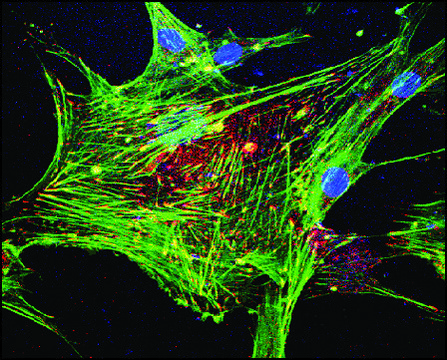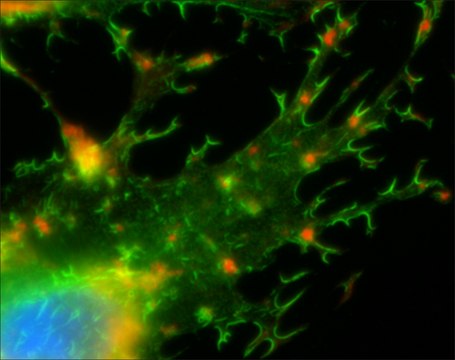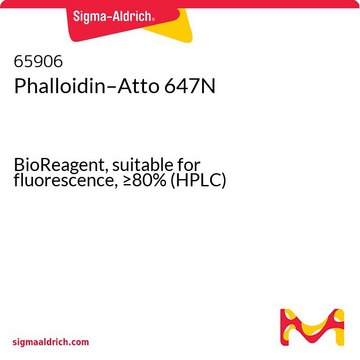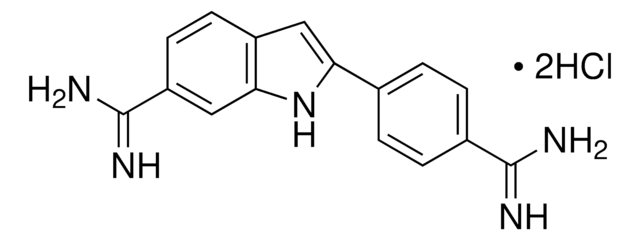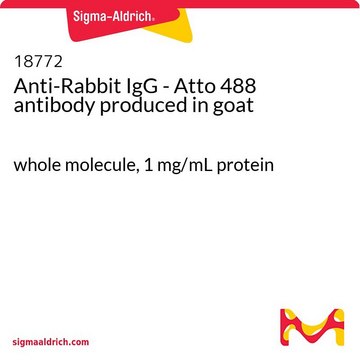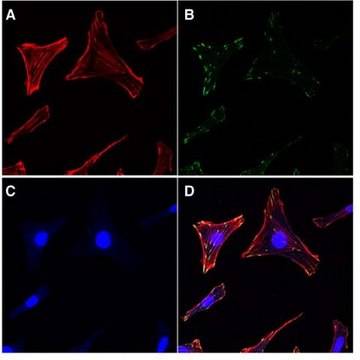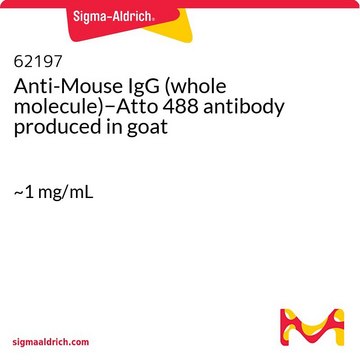18846
Phalloidin–Atto 655
suitable for fluorescence, ≥90.0% (sum of isomers, HPLC)
Synonym(s):
Atto 655 Phalloidin
Sign Into View Organizational & Contract Pricing
All Photos(1)
About This Item
UNSPSC Code:
12352108
NACRES:
NA.32
Recommended Products
Quality Level
Assay
≥90.0% (sum of isomers, HPLC)
form
solid
manufacturer/tradename
ATTO-TEC GmbH
transmittance
254 nm
655 nm
fluorescence
λex 663 nm; λem 684 nm in 0.1 M phosphate pH 7.0
UV absorption
λ: 651- 657 nm Amax
suitability
suitable for fluorescence
storage temp.
−20°C
General description
Atto 655 belongs to a new generation of fluorescent labels. The dye is designed for application in the area of life science, e.g. labeling of DNA, RNA or proteins. Characteristic features of the label are strong absorption, good fluorescence quantum yield, excellent thermal and photo-stability, outstanding ozone resistance, very good water solubility, and very little triplet formation. Atto 655 is a zwitterionic dye with a net electrical charge of zero. The fluorescence is efficiently quenched by electron donors like guanine, tryptophan, etc.Phalloidin is a fungal toxin isolated from the poisonous mushroom Amanita phalloides. Its toxicity is attributed to the ability to bind F actin in liver and muscle cells. As a result of binding phalloidin, actin filaments become strongly stabilized. Phalloidin has been found to bind only to polymeric and oligomeric forms of actin, and not to monomeric actin. The dissociation constant of the actin-phalloidin complex has been determined to be on the order of 3 x 10–8. Phalloidin differs from amanitin in rapidity of action; at high dose levels, death of mice or rats occurs within 1 or 2 hours.
Application
Fluorescent conjugates of phalloidin, rhodamine-phalloidin staining reagents, such as Phalloidin–Atto 655 are used to label actin filaments for histological applications. Some structural features of phalloidin are required for the binding to actin. However, the side chain of amino acid 7 (g-dihydroxyleucine) is accessible for chemical modifications without appreciable loss of affinity for actin.
Legal Information
This product is for Research use only. In case of intended commercialization, please contact the IP-holder (ATTO-TEC GmbH, Germany) for licensing.
Storage Class Code
11 - Combustible Solids
WGK
WGK 3
Flash Point(F)
Not applicable
Flash Point(C)
Not applicable
Personal Protective Equipment
dust mask type N95 (US), Eyeshields, Gloves
Regulatory Information
新产品
Choose from one of the most recent versions:
Already Own This Product?
Find documentation for the products that you have recently purchased in the Document Library.
Ruth Barnard et al.
Cytometry. Part A : the journal of the International Society for Analytical Cytology, 73(4), 299-304 (2008-01-01)
Image-based screening, a new and flexible tool in the drug discovery cascade, is amenable to many different targets. This article describes a particular use of the Cellomics ArrayScan in developing a functional screen for histamine H(4) receptor (H(4)R) antagonists that
Gerlinde R Van de Walle et al.
Veterinary microbiology, 86(1-2), 51-57 (2002-03-13)
Addition of pseudorabies virus (PrV)-specific polyclonal immunoglobulins to PrV-infected monocytes induces internalization of plasma membrane anchored viral glycoproteins. This process may interfere with antibody-dependent cell lysis and resembles the well-studied physiological endocytosis process. A confocal study was designed to investigate
Breaking the Diffraction Barrier in Fluorescence Microscopy by Optical Shelving.
Bretschneider, S.; Eggeling, Chr.; Hell, S. W.
Physical Review Letters, 98(21) (2007)
Rosangela Invernizzi et al.
Oncology, 75(3-4), 237-244 (2008-10-16)
Pegfilgrastim is a covalent conjugate of filgrastim and polyethylene glycol that has proved to be effective in supporting myelopoiesis during chemotherapy. Since very limited information is available on the biological effects of pegfilgrastim on neutrophils exposed to chemotherapy, we analyzed
Takahiro Shimizu et al.
Cell calcium, 45(3), 226-232 (2008-12-03)
We demonstrate here that the transient receptor potential melastatin subfamily channel, TRPM4, controls migration of bone marrow-derived mast cells (BMMCs), triggered by dinitrophenylated human serum albumin (DNP-HSA) or stem cell factor (SCF). Wild-type BMMCs migrate after stimulation with DNP-HSA or
Articles
Atto dyes are a series of fluorescent dyes that meet the critical needs of modern fluorescent technologies.
Our team of scientists has experience in all areas of research including Life Science, Material Science, Chemical Synthesis, Chromatography, Analytical and many others.
Contact Technical Service